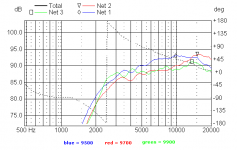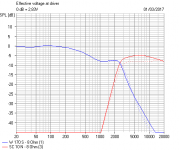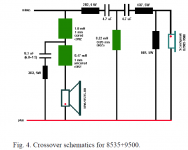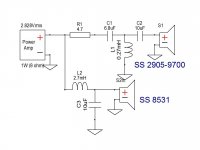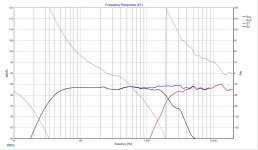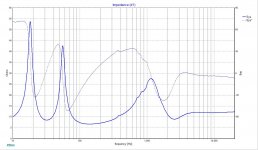Yes i know zaph. But I spent a lot of money for the drivers so I would like to build something with that...
I think modifying Zaph's Revelator Tower to a D2905 9700 would be hard work, since the Fs notch filter would need adjustment too. And we don't have a point of reference with Zaph's tweeter. But I'm sure it could be done.
Troels' SP95 is not hard, IMO, especially thanks to Ralf's digging around..
SP95
Why ScanSpeak tweeters 9500 and 9700 aren'
The 0.07mH coil is just putting back the tweeter voicecoil inductance which tames the rising top. The drop from 5.6R to 2.2R gives you the +3dB you want. Impedance doesn't change significantly, though it's actually a bit low in the SP95 at about 2.5kHz. About 3 ohms.
These ideas apply to any filter really. It would work with a parallel filter too. But I would want to sim any chosen design to be most exact on a modification.
Troels' SP95 is not hard, IMO, especially thanks to Ralf's digging around..
SP95
Why ScanSpeak tweeters 9500 and 9700 aren'
The 0.07mH coil is just putting back the tweeter voicecoil inductance which tames the rising top. The drop from 5.6R to 2.2R gives you the +3dB you want. Impedance doesn't change significantly, though it's actually a bit low in the SP95 at about 2.5kHz. About 3 ohms.
These ideas apply to any filter really. It would work with a parallel filter too. But I would want to sim any chosen design to be most exact on a modification.
Attachments
Last edited:
Hi system7
Thanks for the reply
I have just tried the filter of sp95 with your modifications and it sounds good but i don't like the paper sound of the 18w. Too much mids frequencies....sound is too lushy, too fat in other words...i also tried to bump the damping inside the cabinet on the rear of the woofer but it doesn t have effect.
I would prefer a parallel filter to try to eliminate that excess of 500 -1500 hz...i tried also 2.7mh-10uf-0.47mh 3rd order: it looses basses but mids are always there...can you suggest anything?
Regards
Thanks for the reply
I have just tried the filter of sp95 with your modifications and it sounds good but i don't like the paper sound of the 18w. Too much mids frequencies....sound is too lushy, too fat in other words...i also tried to bump the damping inside the cabinet on the rear of the woofer but it doesn t have effect.
I would prefer a parallel filter to try to eliminate that excess of 500 -1500 hz...i tried also 2.7mh-10uf-0.47mh 3rd order: it looses basses but mids are always there...can you suggest anything?
Regards
I could sim 8531's response in a box and a filter proposal if you can spare the details on baffle measures and box volume, type and tuning.
How on Earth did you do THAT in an hour! I'm impressed. 😱Hi system7
Thanks for the reply
I have just tried the filter of sp95 with your modifications and it sounds good but i don't like the paper sound of the 18w. Too much mids frequencies....sound is too lushy, too fat in other words...i also tried to bump the damping inside the cabinet on the rear of the woofer but it doesn t have effect.
I would prefer a parallel filter to try to eliminate that excess of 500 -1500 hz...i tried also 2.7mh-10uf-0.47mh 3rd order: it looses basses but mids are always there...can you suggest anything?
Regards
It's been an interesting day for me. I've been delving into all sorts of Scanspeak 6" drivers. Mostly at Troels' site. He did a thing called the "2.5_Clone" back in the day with a Scanspeak 18W/8535, which was the scruffy looking one. It's 3kHz crossover is below. Some sibilance issues apparently.
These days, Troels does the 700Hz presence notch on slim baffles with a smaller bass coil. I'm not sure I buy the LCR idea, but he also does a near 6kHz tank notch on the bass in almost all cases. This makes phase fall into place nicely IMO, and gets you much more rolloff which must help with cone breakup. Scanspeak drivers often quote a low Le of 0.3mH with copper damping rings built in, but it always looks more like 0.6mH to me on the impedance plot, being 15 ohms at 10kHz.
I would be extremely interested if Lojzek could do a sim for us. Lots of Scanspeak ideas here:
Studio-101
18W-8434G00
It's a 22cm wide but tower baffle, 32L and 33 Hz tuning in Troels' and Zaph's designs. Tweeter 10 cm from the top and possibly offset to the side, bass 25 cm from the top. John DeVore would put the bass on top, of course...
I've been having quite a good time with the second circuit idea below, but I hate 6" bass. I can never get it sounding right. 😱
Attachments
Last edited:
You have paperish sound most likely due to a present cone resonanse or low tweeter level compared to the midwoofer. Troels prefers to tune his speakers with 1.5-2db recessed tweeter level, it makes sense due to the way our perception of sound works. He likes it this way, I don`t because to me some instruments sound unprecise this way - one very good example is the accordeon. It will sound unnatural no matter what you do until you equalize tweeter and midwoofer level. BBC did introduce a dip in the freq. response to reduce the lushness of mezzo-soprano vocals and push them a bit backwards but retain higher tweeter level in the upper octaves and many commercial (successful) designs using this approach are being liked by the public.
That all being said, I`d suggest if you now use the SP95 crossover, reduce the 5R6 resistor and increase the 6.8uF cap to 8.2uF and see if it clears up. The efficiency of the 9700 is lower (up to 3.5Khz) compared to the 9500 and it does not exhibit the broad peak at 1.6Khz, I am sure this peak has been addressed in the SP95 crossover and this leads to an even bigger difference in levels between the two tweeters. The 9700 has a stronger peak at Fs due to the (possible) lack of ferrofluid in the gap, this will need its own RLC circuit or at least a parallel resistor ir it will ring at the right frequency. The two tweeters are not interchangeable, each requires its dedicated crossover.
I would tweak the midwoofer crossover too. Increase the 2.2mH coil to 2.7mH and reduce the 6.8uF cap to 5.6uF or even better - to 4.7uF. You can ommit 3R3, it is there to shape the knee and allow better phase tracking but in your case will complicate things a you lack measurement equipment. The RLC network introduced on the midwoofer is not necessary for good sound, the larger coil would do the job. Instead of buying a new coil, drop a nut or bolt in the coil gap and test this way, you can vary the level by introucing larger/smaller ferrous pieces.
Can you post your crossover schematic and enclosure loading of the midwoofer?
That all being said, I`d suggest if you now use the SP95 crossover, reduce the 5R6 resistor and increase the 6.8uF cap to 8.2uF and see if it clears up. The efficiency of the 9700 is lower (up to 3.5Khz) compared to the 9500 and it does not exhibit the broad peak at 1.6Khz, I am sure this peak has been addressed in the SP95 crossover and this leads to an even bigger difference in levels between the two tweeters. The 9700 has a stronger peak at Fs due to the (possible) lack of ferrofluid in the gap, this will need its own RLC circuit or at least a parallel resistor ir it will ring at the right frequency. The two tweeters are not interchangeable, each requires its dedicated crossover.
I would tweak the midwoofer crossover too. Increase the 2.2mH coil to 2.7mH and reduce the 6.8uF cap to 5.6uF or even better - to 4.7uF. You can ommit 3R3, it is there to shape the knee and allow better phase tracking but in your case will complicate things a you lack measurement equipment. The RLC network introduced on the midwoofer is not necessary for good sound, the larger coil would do the job. Instead of buying a new coil, drop a nut or bolt in the coil gap and test this way, you can vary the level by introucing larger/smaller ferrous pieces.
Can you post your crossover schematic and enclosure loading of the midwoofer?
Last edited:
Hi everbody and thanks for all the replies!
sure I can give any detail about my building: the box is the same of Troel's SP95. My idea was to build the SP95 but the seller sent me the D2905/9700 instead of the D2905/9500 that I've ordered, and he told me not to care about his mistake 'cause both tweeters are the same 🙁

@ Lojzek the quotes of the baffle are the same of the picture, so also the position of the drivers on it. Internal netto volume is about 32 Liters, bass reflex is in the bottom of the speaker (like ProAc d28) . Port tuning is 34 Hz (ID 66x170).
Internal Damping is :
-2mm bitumen pads + 10mm felt
-30mm smooth foam.
Ask me for any other detail, I hope all these can be enough for you to help me.
regards
sure I can give any detail about my building: the box is the same of Troel's SP95. My idea was to build the SP95 but the seller sent me the D2905/9700 instead of the D2905/9500 that I've ordered, and he told me not to care about his mistake 'cause both tweeters are the same 🙁

@ Lojzek the quotes of the baffle are the same of the picture, so also the position of the drivers on it. Internal netto volume is about 32 Liters, bass reflex is in the bottom of the speaker (like ProAc d28) . Port tuning is 34 Hz (ID 66x170).
Internal Damping is :
-2mm bitumen pads + 10mm felt
-30mm smooth foam.
Ask me for any other detail, I hope all these can be enough for you to help me.
regards
You have paperish sound most likely due to a present cone resonanse or low tweeter level compared to the midwoofer. Troels prefers to tune his speakers with 1.5-2db recessed tweeter level, it makes sense due to the way our perception of sound works. He likes it this way, I don`t because to me some instruments sound unprecise this way - one very good example is the accordeon. It will sound unnatural no matter what you do until you equalize tweeter and midwoofer level. BBC did introduce a dip in the freq. response to reduce the lushness of mezzo-soprano vocals and push them a bit backwards but retain higher tweeter level in the upper octaves and many commercial (successful) designs using this approach are being liked by the public.
That all being said, I`d suggest if you now use the SP95 crossover, reduce the 5R6 resistor and increase the 6.8uF cap to 8.2uF and see if it clears up. The efficiency of the 9700 is lower (up to 3.5Khz) compared to the 9500 and it does not exhibit the broad peak at 1.6Khz, I am sure this peak has been addressed in the SP95 crossover and this leads to an even bigger difference in levels between the two tweeters. The 9700 has a stronger peak at Fs due to the (possible) lack of ferrofluid in the gap, this will need its own RLC circuit or at least a parallel resistor ir it will ring at the right frequency. The two tweeters are not interchangeable, each requires its dedicated crossover.
I would tweak the midwoofer crossover too. Increase the 2.2mH coil to 2.7mH and reduce the 6.8uF cap to 5.6uF or even better - to 4.7uF. You can ommit 3R3, it is there to shape the knee and allow better phase tracking but in your case will complicate things a you lack measurement equipment. The RLC network introduced on the midwoofer is not necessary for good sound, the larger coil would do the job. Instead of buying a new coil, drop a nut or bolt in the coil gap and test this way, you can vary the level by introucing larger/smaller ferrous pieces.
Can you post your crossover schematic and enclosure loading of the midwoofer?
Hi, I have tried 2 topologies of crossover:
With parallel filter (using 2.2mh or 2.7mh) 2nd or 3rd order I tried to listen only to the midwoofer leaving out the tweeter and it always sounds too lush and too medious. So i think the boring sound comes from the woofer.
With sp95 series filter things go a little better but sound is round and not detailed. I thing 18w in this configuration sounds a little better.
The woofer does not extend that high as some modern drivers and you have the non-coated version. If you listen to it bare, it will have a specific paperish sound because its uncoated, when you add the tweeter (properly integrated) it will mask it. If you coat it, the paperish sound will go away at the expense of detail. I wouldn`t. Look at the loudspeaker as a whole, add the tweeter, try the above changes to the crossover and share the results.
Ok.
But i wouldnt go for the series crossover cause it seem a bit confused..
Can you recommend a parallel filter or a frequency for crossing the driver? best to cross them high (2.5khz-3khz) or low (1.5khz-2khz)?
But i wouldnt go for the series crossover cause it seem a bit confused..
Can you recommend a parallel filter or a frequency for crossing the driver? best to cross them high (2.5khz-3khz) or low (1.5khz-2khz)?
Last edited:
I have a ready made mixture of Zaph and SP 95 filter parts to try out. 2,7 mH is essentially right. 12 uF instead of 10 uF in LP looks better, similar with 4R7 and 5R6 for padding resistor. Give it a try.
Attachments
This is exactly the filter i m trying right now but it is bad. Good on simulator but not so good in reality.
Maybe i have a problem on the damping material. Too mifs from 18w. Sound is nasal and prickly
Maybe i have a problem on the damping material. Too mifs from 18w. Sound is nasal and prickly
Sound is nasal and prickly
Sounds to me like the 1khz area needs dropping.
Right said Marley, cabinet air modes of width and depth fall in this category. Damping needs to be of suffiecient quantities to address it properly, and without measurements, it's unclear. I do the damping similar to sealed boxes with exception of making space for the vent to breathe.
Maybe.
I am worried because Troels describes the sp95 as a coloured speaker, despite using the notch filter for 500-1500hz that he says is a couple db's too loud. But he also says that the speaker can run also without a notch filter and the price to pay is more colourness on voices but also more live effect.
I never tried to drop 1khz zone because it seems to drop also 800 -2khz
Suggestions?
Regards
I am worried because Troels describes the sp95 as a coloured speaker, despite using the notch filter for 500-1500hz that he says is a couple db's too loud. But he also says that the speaker can run also without a notch filter and the price to pay is more colourness on voices but also more live effect.
I never tried to drop 1khz zone because it seems to drop also 800 -2khz
Suggestions?
Regards
Right said Marley, cabinet air modes of width and depth fall in this category. Damping needs to be of suffiecient quantities to address it properly, and without measurements, it's unclear. I do the damping similar to sealed boxes with exception of making space for the vent to breathe.
I made an impedance measurement and i have not any issue...
Measure the response of each driver with and without filter at some distance in far field (1 m), and their sum. Also a near field of woofer.
Ehm...i have no calibrated microphone
I can make a measure with sweep and microphone....can be useful?
I can make a measure with sweep and microphone....can be useful?
It would be useful. Try to measure as far as possible from obstacles in your room and place the speaker on an elevated stand. Keep the time window as long as you can before the room starts interfering. Leave the mic at a spot of your interest, maybe tweeter axis or between the tweeter and woofer.
Read this:
How to Achieve Accurate In-Room Quasi-Anechoic Free-Field ...
Read this:
How to Achieve Accurate In-Room Quasi-Anechoic Free-Field ...
- Home
- Loudspeakers
- Multi-Way
- Scan-Speak crossover help
